Don’t get me started on the topic of traditional cookie molds. I could wax on for hours about the beauty, history, tradition, importance (in times gone by), the craft of the carvers, the skill of the bakers and of the varieties of the cookies themselves. During my 6 years living in Switzerland, I was a huntress – scouring second hand shops (called Brocki) on an almost weekly basis in pursuit of traditional Swiss molds. My infrequent finds made me wildly ecstatic, even though I knew these treasures ended up at the Brocki because an elderly woman or retired baker had either died or went off to live in an old age home and their children had no interest whatsoever in taking the time to make such time-consuming treats. I am not embarrassed to admit that finding the tiniest hint of dough remnants still stubbornly clinging to a once oft-used mold sometimes brought tears to my eyes as I thought of the carver, now most certainly long gone, and the mother, grandmother or baker who had carried on the wonderful tradition.
While at my favorite Christmas market in Europe in my family’s home city of Munich, I came upon a booth selling astonishingly large, lovely and detailed Springerle, a traditional white anise-flavored cookie found in Germany and many parts of Switzerland. My eye immediately went to the wild boar cookie.
Lest you wonder why, among the fabulous assortment, I was drawn to this one, let me explain. When I married my husband many-a-year ago, I gave up my Swiss maiden name of Landolt and adopted his family name, Eber. I really should have pulled out a German dictionary. Eber translates to “wild boar”. Once I figured this out, years after the nuptials, I decided to embrace it rather than be mortified.
I never ate the cookie. Rather, I carefully stored it away in the hope that, someday, I would find someone to carve a replica. That happy day came when I was doing a radio show on a traditional treat in the stunning town of Appenzell, Switzerland.
When I asked the bakers what they would do if the carved, wooden molds with a generations-old design unique to their bakery broke, they shrugged and answered, “Guido Neff will carve us a new one.” I had a name!! The bakers told me his woodcarving family has been crafting cookie molds, as well as doors, furniture and headstones for generations. After my interview, I walked up the road and knocked on his beautifully carved door.
Once inside his workshop, I gushed in my terrible German (I did not even attempt Appenzeller Swiss German) about my passion for traditional cookie molds and asked if he would carve the wild boar mold for me. While he likely did not understand much of what I said, he most certainly realized my interest and enthusiasm. It was then he told me a family in town had recently renovated a very old building that once housed a bakery. When the workers went into the attic, they came upon boxes of old wooden Biber (soft, gingerbread-like cookie) molds that had been used 75 to 100 years ago and carved by his grandfather. “Would you like to see them?”, he asked. He returned shortly with the find and let me paw through and gush over each and every one. Below are just a few of his grandfather’s fabulous works of art representing life long ago in Appenzell.
While I wanted to possess each and every one, the depiction of the Appenzell farmers and their cows descending from summering in the Alp had to be mine.
I have seen this and many other cow descents throughout Switzerland and adored every one. It was amazing to find that the representation in the carving looked incredibly like the descent I had witnessed. Little has changed in the 100 years since Herr Neff’s grandfather made his carving. This wonderful man agreed to make an exact replica of the 16″ by 8″ mold for me. I emphasized that I wanted it to be an EXACT representation. Every bell, pipe, curl of hair, walking stick and button had to be the same.
Two months later I got the call that my (very expensive) wild boar and Appenzell Alpaufzug pear wood molds were ready. I cannot even begin to explain how thrilling it was to see what Herr Neff had made. First, the wild boar. Below is a picture of the concave, 10″ by 6″ mold and the Springerle it was copied from.
Next, the end of summer descent of the farmers and dairy cows from the Appenzell Alps. He used 34 different wood carving tools to achieve the same detail as his grandfather.
Close-up detailed photographs.
I have been happily baking Springerle using my wild boar mold and am attempting to replicate the delicious, well-guarded Appenzell Biber recipe.
Below are links to source wonderful molds in the U.S. as well as to find recipes for use in the molds:
SPRINGERLE JOY (A wonderful replica of an old Appenzell Alpaufzug mold.)
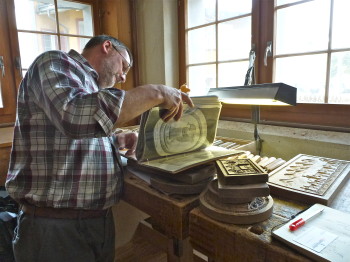
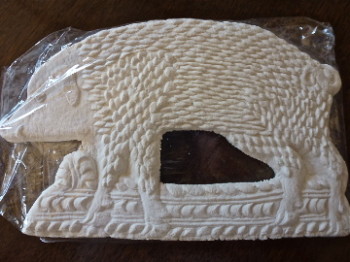
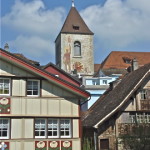


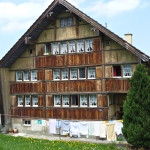
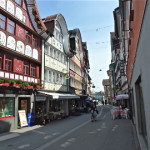
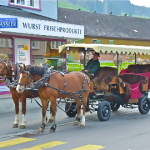

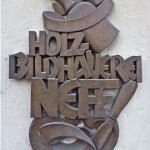
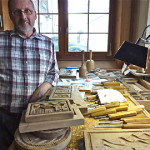
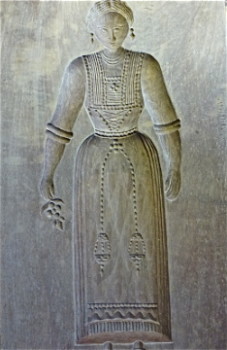
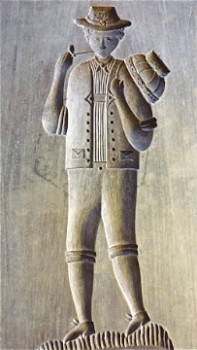

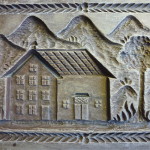

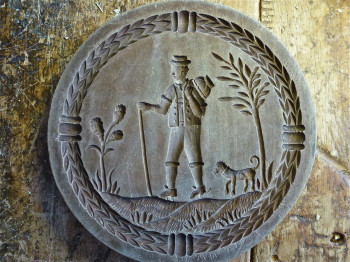

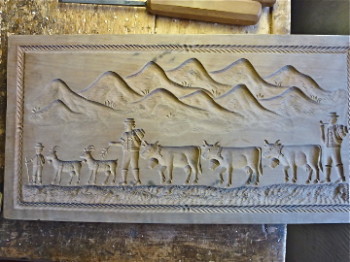
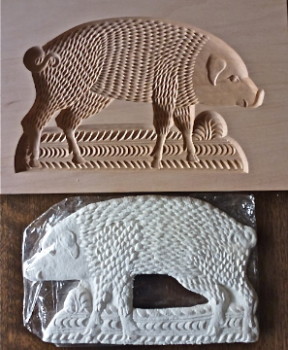
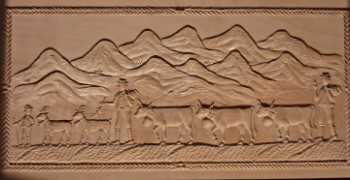
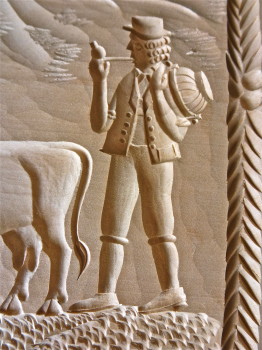
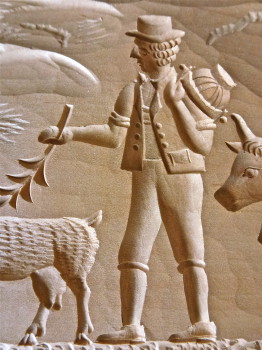

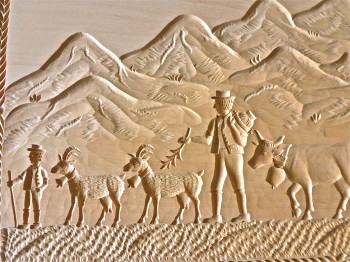
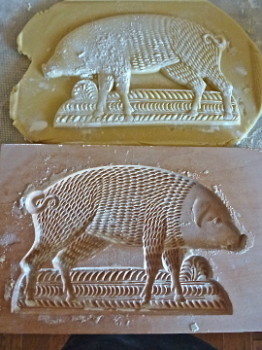
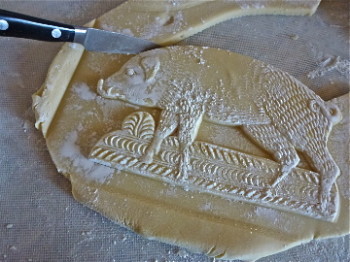
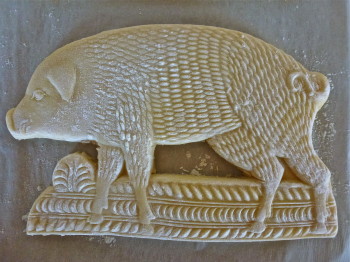
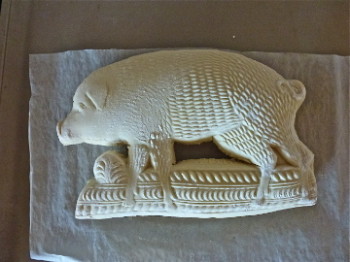





Love your beautiful cookie cutters
Test
Thank you for sharing the name of the mold maker. I have a small company that makes cookies and I would like to contact Mr Neff to ask him to make me a mold with our logo. By the way, I live in Leesburg, Virginia in the United States but I am Peruvian by birth.
I am a first-generation Swiss making Biberli in Indiana. I am also a woodcarver and would like to try making a Biberli mold. Can you tell me anything about preferred woods for this purpose, how the wood carving might be finished (coated) and where in the Biberl-making process the print is applied?
The carvers I know in Switzerland always use a fruit tree wood as it is strong and not very pourous. I can ask them what finish they apply. I think the same mineral oil used for butcher blocks but you could probably verify someplace on-line.
To make the Biberli, mold cavity is face up. Press dough in, fill cavity with marzipan then lightly rim the edge with water. Some don’t do this water/glue step. Place another dough piece on top, seal edges, flip over to remove the Biberli and cut excess dough. A method I prefer is placing top half of a large piece of dough over the cavity. Press, fill then flip excess over. One less seam this way.
Thank you. Initially, I was concerned that the dough would stick to the wood mold, but now I think that the dough loses a lot of its tackiness when refrigerated overnight. I just need to find a good piece of wood now !
Always dust the mold with flour or rice flour. If the dough sticks, it needs more flour.
I love your stories. Especially of Herr Neff and his attic full of his grandfather’s molds. What a treat!
I’m in northern Cali too, Bay Area . Are you near me. Found your site after searching for Swiss cookie mold . My Swiss friend is coming from Geneva and I’d love a Swiss mold like yours .,
Any suggestions ?